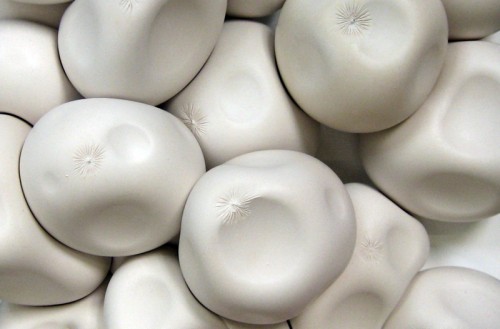Buckminster, Meet Plato
Mining the vast pool of ideas within mathematics, physics and molecular biology Dominic Hopkinson generates sculptures in
stone and plaster, attempting to distil these complex concepts into pure visual form. The sculptures question how our world appears so similar at different scales and invites the audience to impose their own reading of scale upon it.
This exhibition brings together stone carving, plaster casts and bronze castings that explore the nature of form and philosophy. Playing with concepts of scale, tone and shadow, the work talks of a universal mathematical structure that influences and guides our world experience at many levels. These plaster works are informed by Buckminster-Fuller’s closest packing theories and what Marcel Duchamp called the “infra-slim”, the tiny, almost non-existent space between the cast object and the mould.
We asked Dominic to tell us more about the scientific theories that have influenced his exhibition, here’s what he had to say:
The exhibition contains a series of sculptural works in stone, plaster and bronze, as well as drawings and models that I am showing to the public for the very first time.
All the work derives from my research into many scientific fields, most notably the relationship of the Golden Ratio (known as phi in mathematics and expressed as the number 1.6180339887…) to the structures underlying many natural and mathematical phenomena. Phi is a significant number in both maths and art; it is irrational meaning it can’t be expressed as a whole fraction, and like pi the numbers after the decimal place continue infinitely without falling into any recognisable pattern. Phi is known as an harmonic ratio, the standard western aesthetic of rectangles for picture frames, windows T.V’s etc has evolved from the harmonic relationship of the length of a rectangle to its height. In music it is found in the ratio of the different lengths of sound waves or plucked strings.
Phi crops up in nature too, since most plants grow in a spiraling fashion evidenced in things like fir cones, pineapples, seed heads, etc all of which are precisely defined within 3 dimensional space using phi. The way plants grow is dictated by the branching angle of 137.5 degrees, which when expressed as a ratio of a whole circle is 222.5/137.5 = 1.618181818 which is incredibly close to phi.
It is the structures within nature that are created using mathematics that so interest me.
Buckminster-Fuller’s theories of closest packing are directly related to phi in a number of ways. Closest packing is the study of how spheres pack in space (how many oranges can you fit into a box for example, to be basic) but also how spheres and closely related forms pack in three dimensional space is what drives the maths behind the growth spirals in natural structures, plants, petals on flowers, snail shells etc. Also closest packing is directly related to the Platonic Solids (The Platonic Solids are:
Tetrahedron, made up of four triangular faces.
Cube, made up of six square faces.
Octahedron, eight triangular faces.
Dodecahedron, twelve pentagonal faces.
Icosahedron, twenty triangular faces.)
The five Platonic Solids are distinguished by the following properties: they are the only existing solids in which all the faces of any given one of the forms are identical and equilateral, and each of the solids can be circumscribed by a sphere (with all vertices touching the sphere’s surface). Also each of the five forms can be created using closest packing of spheres.
This relates to the title of the exhibition “Buckminster, Meet Plato” which is a jokey kind of introduction, as if they were meeting at a party, except they are drawn together by my work.
I am fascinated by all these theories and concepts as well as many more, which is strange since maths and science were not very well understood by me at school. However, after accidently reading an article in an art magazine by Benoit Mandelbrot, the guy who discovered Fractals, I became fascinated with the relationships between art and the sciences, at a theoretical, conceptual level as well as at an aesthetic level. I think that daily scientists generate astonishing images and effects in their work, which they often view as nothing more than data or results, the images being by products of their process. I try to take these results and create works of art that have as their start point something profound and interesting from a scientific sense and which hopefully are viewed by an audience as beautiful, enigmatic, yet thought provoking sculptures.
I enjoy the juxtaposition of using very traditional materials and processes like stone carving and plaster and bronze casting to create work that deals with many ideas that are at the leading edge of contemporary scientific research.
Dominic’s exhibition closes on the 15th March, for more information visit the York College Gallery website

I do not even know how I ended up here, but I thought this post was great.
I do not know who you are but definitely you’re going
to a famous blogger if you aren’t already 😉 Cheers!